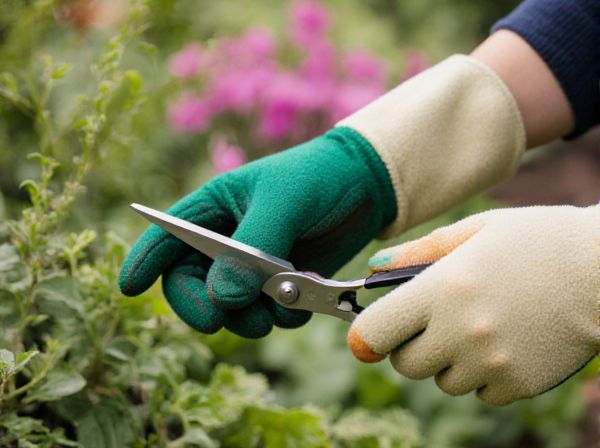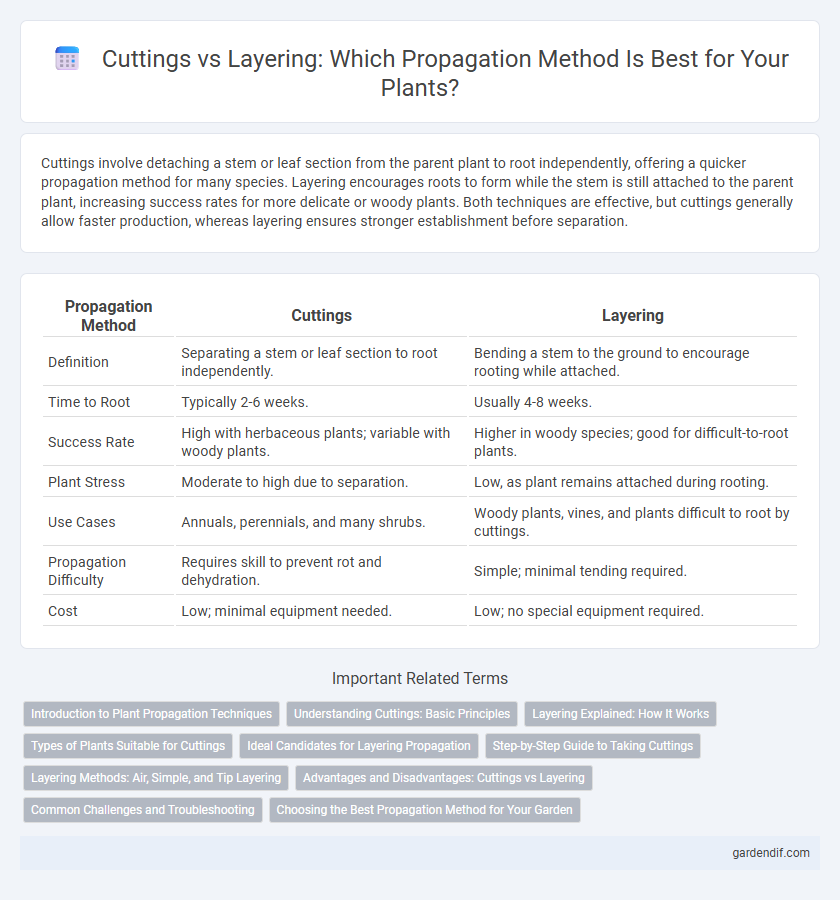
Cuttings vs Layering Illustration
Cuttings involve detaching a stem or leaf section from the parent plant to root independently, offering a quicker propagation method for many species. Layering encourages roots to form while the stem is still attached to the parent plant, increasing success rates for more delicate or woody plants. Both techniques are effective, but cuttings generally allow faster production, whereas layering ensures stronger establishment before separation.
Table of Comparison
| Propagation Method | Cuttings | Layering |
|---|---|---|
| Definition | Separating a stem or leaf section to root independently. | Bending a stem to the ground to encourage rooting while attached. |
| Time to Root | Typically 2-6 weeks. | Usually 4-8 weeks. |
| Success Rate | High with herbaceous plants; variable with woody plants. | Higher in woody species; good for difficult-to-root plants. |
| Plant Stress | Moderate to high due to separation. | Low, as plant remains attached during rooting. |
| Use Cases | Annuals, perennials, and many shrubs. | Woody plants, vines, and plants difficult to root by cuttings. |
| Propagation Difficulty | Requires skill to prevent rot and dehydration. | Simple; minimal tending required. |
| Cost | Low; minimal equipment needed. | Low; no special equipment required. |
Introduction to Plant Propagation Techniques
Cuttings and layering are fundamental plant propagation techniques that enable gardeners to produce new plants from existing ones. Cuttings involve severing a part of the parent plant, such as a stem or leaf, and encouraging root development to form an independent plant. Layering entails bending a low branch to the ground, covering it with soil to stimulate root growth while still attached to the parent plant, providing a higher success rate for certain species.
Understanding Cuttings: Basic Principles
Cuttings propagate plants by removing a portion of the stem, leaf, or root to stimulate new growth from the excised part. Success depends on factors like the cutting type (softwood, semi-hardwood, hardwood), hormone application for root development, and environmental conditions such as humidity and temperature. Understanding these basic principles improves rooting rates and ensures effective vegetative propagation.
Layering Explained: How It Works
Layering is a propagation technique where a stem is encouraged to develop roots while still attached to the parent plant, ensuring nutrient flow and increasing success rates. It involves bending a flexible shoot to the ground or another substrate, wounding it slightly, and covering the wounded section with soil or moss to stimulate root formation. Once rooted, the new plant can be severed from the parent, enabling growth as an independent specimen with established root systems.
Types of Plants Suitable for Cuttings
Softwood, semi-hardwood, and hardwood cuttings are ideal for propagating a wide variety of plants, including herbs like basil and mint, ornamentals such as coleus and hydrangea, and many shrubs like azaleas and boxwood. Woody plants, including roses and some fruit trees, respond well to hardwood cuttings taken during dormancy. Succulents and houseplants like pothos and philodendrons also root effectively from stem cuttings, making cuttings a versatile propagation method for diverse plant species.
Ideal Candidates for Layering Propagation
Ideal candidates for layering propagation include plants with flexible stems such as raspberries, blackberries, and certain shrubs like azaleas and rhododendrons. This method suits species that naturally produce aerial roots or have stems that can easily root when in contact with soil. Layering is most effective for woody plants and those difficult to propagate through cuttings due to high moisture retention or slow root development.
Step-by-Step Guide to Taking Cuttings
Taking cuttings involves selecting healthy stems, typically 4-6 inches long, and removing lower leaves to expose nodes for root development. Dip the cuttings in rooting hormone and insert them into a well-draining medium like perlite or a peat blend, maintaining consistent moisture and warmth around 70-75degF (21-24degC). Root formation usually occurs within 2-4 weeks, after which cuttings can be transplanted into regular potting soil for continued growth.
Layering Methods: Air, Simple, and Tip Layering
Layering methods such as air, simple, and tip layering enable plants to develop roots while still attached to the parent, ensuring higher success rates compared to cuttings. Air layering involves wounding a stem and encasing it with moist medium to promote root formation, suitable for woody plants. Simple layering bends a low branch to the soil where it roots naturally, while tip layering encourages root growth from the branch tip buried in soil, both effective for shrubs and vines.
Advantages and Disadvantages: Cuttings vs Layering
Cuttings offer a faster propagation method with the advantage of producing genetically identical plants but often require precise humidity and temperature control to root successfully, leading to higher initial care. Layering, while slower, benefits from using the parent plant's established root system, increasing survival rates and reducing transplant shock, but it may occupy more space and take longer to yield new plants. Understanding the trade-offs between cuttings and layering helps optimize propagation strategies based on species, timing, and resource availability.
Common Challenges and Troubleshooting
Cuttings often face challenges like poor root development and fungal infections, requiring sterile tools and optimal moisture control to encourage healthy growth. Layering may encounter issues such as stem breakage or delayed root formation, which can be mitigated by ensuring proper wound treatment and consistent environmental conditions. Both propagation methods demand vigilant monitoring for pests and adaptable techniques to overcome rooting difficulties.
Choosing the Best Propagation Method for Your Garden
Cuttings provide a rapid propagation method ideal for woody shrubs and herbaceous plants, producing clones with identical traits to the parent. Layering encourages root development while the stem remains attached to the mother plant, improving success rates for difficult-to-root species and reducing transplant shock. Selecting cuttings or layering depends on plant type, seasonal conditions, and desired propagation speed for optimal garden growth.
Cuttings vs Layering Infographic

 gardendif.com
gardendif.com